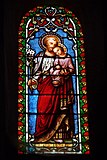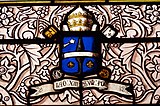Notre-Dame-de-l'Assomption (Moustiers-Sainte-Marie)
The Catholic parish church of Notre-Dame-de-l'Assomption ( Assumption ) in Moustiers-Sainte-Marie , a municipality in the Alpes-de-Haute-Provence in the French region of Provence-Alpes-Cote d'Azur , is a Romanesque 12th century church. It has a particularly beautiful bell tower built in the Lombard style . In 1913, the church was added to the list of architectural monuments in France as a monument historique .
history
Originally Notre-Dame-de-l'Assomption belonged to a priory of Lérins Abbey . In the 5th century, Bishop Maximus von Riez settled monks from a monastery on the Lérins Islands , founded by Saint Honoratus of Arles on the Île Saint-Honorat , at the entrance to the Verdon Gorge . The monks lived in caves that they had cut into the rocks. The place was called Monasterium , from which the name Moustiers developed. When Provence came under Moorish rule from the 8th century until the end of the 10th century , the monks were expelled. It was not until the end of the 11th century that a religious order was established again in Moustiers.
In 1097 the Bishop of Riez placed the church of Moustiers with other churches in the area under the abbot of Lérins and in 1113 confirmed the ownership of these churches and their benefices . Until the secularization of 1787, Moustiers remained a priory of the Lérins Abbey. From the middle of the 16th century there were no more monks in Moustiers and secular clergy held their office.
architecture
Exterior construction
The church and bell tower are made of tufa-lime .
On the south side of the church, on which the portal is also located, the 22-meter-high, square bell tower rises. It has five floors tapering towards the top. The two lower floors are made of rough quarry stone masonry . The three upper floors are made of carefully hewn stones. They are broken up by twin arcades of different sizes and decorated with pilaster strips , blind arcades and arched friezes .
In the 17th century, the tower, which was exposed to constant vibrations from the bells, had to be secured with iron anchors and reinforced with buttresses .
inner space
The interior of the church has a single nave and is divided into five bays . It is covered by a pointed barrel, which is underpinned by belt arches . The weight of the vault rests on the wall pillars , which are connected to one another by round arches.
The three-bay choir was added to the Romanesque nave in the 14th century in the Gothic style . It is closed at right angles and covered with a ribbed vault supported by pointed arches .
The transept arms were added in the 17th century.
Leaded glass window
The lead glass windows of the church are from a later period. In addition to the apostles Peter and Paul , Joseph and the baby Jesus , the nun Margareta Maria Alacoque , who appears to Jesus as he points to his heart, they represent Pope Pius IX. Some windows have signatures (V / J or André & Pascal Aix 1879).
The middle of the choir wall is pierced almost in its entire height by a narrow arched window, the central representation of which is dedicated to Mary , the patron saint of the church. The pilgrimage chapel Notre-Dame de Beauvoir, which is elevated above the town, is shown in the lower field.
Coat of arms of Pope Leo XIII.
Furnishing
A reused marble sarcophagus from the Gallo-Roman period serves as the altar .
literature
- Thorsten Droste : Dauphiné and Haute-Provence. Discovery trips between the Rhône and the Alps, from Lyon to the Verdon Gorge . DuMont-Verlag, Cologne 1992, ISBN 3-7701-2408-1 , pp. 328-329.
- Jacques Thirion: Romanesque style of the Côte d'Azur and the Maritime Alps . Echter Verlag , Würzburg 1984, ISBN 3-429-00911-1 , pp. 315-320.
Web links
Individual evidence
- ↑ Église Notre-Dame-de-l'Assomption in the Base Mérimée of the French Ministry of Culture (French)
Coordinates: 43 ° 50 ′ 50.2 ″ N , 6 ° 13 ′ 19.5 ″ E







